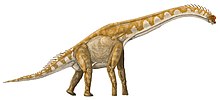Giraffatitan
Giraffatitan is a genus of sauropod dinosaur from the Upper Jurassic of Africa. With a total length of up to 26 meters, this dinosaur is one of the largest land animals in the history of the earth. The first fossils come from the site of Tendaguru in former German East Africa (now Tanzania), where they were found by a German expedition that took place between 1909 and 1912.
Together with other genera, Giraffatitan forms the taxon Brachiosauridae due to common anatomical features (synapomorphies) such as the long forelegs and the high positioned nostrils. Giraffatitan is the sister genus of Brachiosaurus, to which it was originally placed by Werner Janensch. Janensch described two species, Brachiosaurus brancai and Brachiosaurus fraasi, but soon determined that B. fraasi was a younger synonym of B. brancai.
In 1988, Gregory S. Paul pointed out a number of differences between the North American type species of Brachiosaurus (B. altithorax) and the African material and placed B. brancai in its own subgenus Giraffatitan. George Olshevsky considered these differences significant enough to elevate Giraffatitan to a genus. Close examination by Michael Taylor showed that this distinction was justified, as the differences between the two species are significantly greater than those between other well known sauropod genera, such as Diplodocus and Barosaurus.
A skeleton of Giraffatitan is on display in the Berlin Museum für Naturkunde, which was selected as Fossil of the Year 2012 by the Paleontological Society. It consists of skeletal material from several individuals and also contains the material of the holotype (HMN SII). The accompanying Guinness World Records certificate for the record of the world's largest dinosaur skeleton continues to refer to it as Brachiosaurus brancai.

Live reconstruction of giraffatitan
Questions and Answers
Q: What is Giraffatitan?
A: Giraffatitan is a genus of sauropod dinosaurs that lived during the Upper Jurassic, about 140 million years ago.
Q: How long was Giraffatitan?
A: Giraffatitans were about 23-metre (75 ft) long.
Q: How much did they weigh?
A: They weighed about 40 tonnes (88,000 lb).
Q: What features did they have?
A: They had very long necks and were obviously adapted for feeding on tall conifers.
Q: Where did they live?
A: They lived in what is now Tanzania.
Q: When was it first named as an African species of Brachiosaurus? A: It was first named as an African species of Brachiosaurus (B. brancai) in 1914.
Q: Who said there were enough differences to make its own genus? A: George Olshevsky said there were enough differences to make its own genus, creating Giraffatitan in 1991.
Search within the encyclopedia